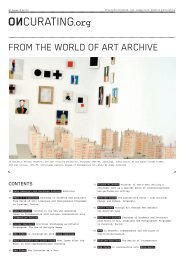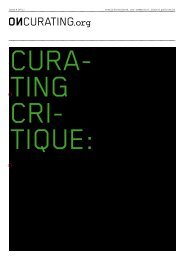You also want an ePaper? Increase the reach of your titles
YUMPU automatically turns print PDFs into web optimized ePapers that Google loves.
086 Issue # 11/11 : PublIc Issues<br />
arises from a necessity to draw from and merge different disciplines and<br />
perspectives from many voices.<br />
Often you are <strong>as</strong>ked to develop projects that accompany urban plan-<br />
ning. For example the Dwaallicht (2007) project in Rotterdam. In your<br />
experience, what expectations do the cities or developers have about you<br />
<strong>as</strong> an artist?<br />
Often the expectations of the developers are their own immediate interests<br />
in executing an urban redevelopment or m<strong>as</strong>ter plan with <strong>as</strong> little friction<br />
<strong>as</strong> possible with the involved parties, such <strong>as</strong> the local population,<br />
inhabitants, shopkeepers, and other users. The hope an art project will<br />
smooth the process and e<strong>as</strong>e the pain. (fig. 3) Like in the Nieuw Crooswijk<br />
area in Rotterdam, where a m<strong>as</strong>sive regeneration took place, tearing down<br />
more than 90 percent of the social-sector dwellings and replacing them<br />
with middle-cl<strong>as</strong>s residences, which displaced 90 percent of the residents,<br />
mainly working-cl<strong>as</strong>s people from a whole range of ethnic backgrounds.<br />
They b<strong>as</strong>ically <strong>as</strong>ked for a project of nice saying goodbye events. When I<br />
accept engage such a commission, it is because I feel an urgency to<br />
address precisely the formulation of the commission and the implied posi-<br />
tion of the local inhabitants. I try to create a more radical narrative<br />
from within. I know this implies the risk of my being completely co-opted<br />
by the commissioning body. This is why I always also try to break open<br />
the commission by arranging independent funding and co-commissioners.<br />
And what are the interests and aims you have when becoming<br />
involved in such projects?<br />
I aim to create platforms of exchange that bring together all urban<br />
forces, thereby enabling the development of places where intimate social<br />
and formal situations can meet. From this exchange, and through meeting<br />
and confrontation, I envisage a more broadly supported and comprehensive<br />
idea of living together in an area. As it is precisely at this moment<br />
that a community begins to shape itself, begins to articulate its own voice<br />
and aesthetic, and begins to organize itself, it becomes clear that it<br />
knows what it actually wants with its environment. At such a moment, you<br />
will see people rising up and demanding the right to the area.<br />
are<strong>as</strong>?<br />
What do you think is most often forgotten when planning new urban<br />
Most new urban are<strong>as</strong>, and IJburg outside Amsterdam comes to mind <strong>as</strong> an<br />
extreme example, are devised completely on a drawing board. The amount of<br />
planning done is intense, and the future of its inhabitants is often<br />
charted for more than 20 years, calculated around the incre<strong>as</strong>ing amounts<br />
of people that will come to live there and building services for them<br />
when certain population metrics are met. I think that these are<strong>as</strong> lack<br />
space for the unplanned, the yet to be desired. They lack space for<br />
people who move into such overregulated places to try to make them their<br />
own, to establish a habitat that might differ from the planners' original<br />
intentions.<br />
The Blue House on IJburg tried to be such a place, one that offers the<br />
opportunity to express these frictions, to match local desires with<br />
external imagination, and to intervene in these processes of accustomization.<br />
On an island that h<strong>as</strong> become almost fully privatized, it is<br />
one of the few public places that can give voice to the struggles of an<br />
emerging community. (fig. 4)<br />
Your projects, such <strong>as</strong> Face your World, StedelijkLab Slotervaart<br />
(2005) in Amsterdam, where you designed the plans for a park together with<br />
the local residents, often try to engage the inhabitants. In your ex-<br />
perience, which factors are needed for people to be willing to actively<br />
participate in such processes?<br />
To be able to create with and from within the community, my projects<br />
depend on the community for their sustainability. For the work to become<br />
more than my single ownership, but the collective ownership of everyone<br />
involved, it is essential for the projects to step into the community<br />
and become part of them, and to develop the ability to listen to how to<br />
interject my creative energy. For this you simply have to spend time,<br />
3 — Dwaallicht (Will o the wisp)— The knight of<br />
memory, 2007, Rotterdam, Nieuw Crooswijk. Photo:<br />
Roger Teeuwen<br />
4 — Het blauwe Huis (The blue House), 2005-<br />
2010 — Pump up the blue by Herve Paraponaris, 2008,<br />
Amsterdam, Ijburg. Photo: Ramon Mosterd


![Download as PDF [10.6 MB]](https://img.yumpu.com/4266533/86/500x640/download-as-pdf-106-mb.jpg)

